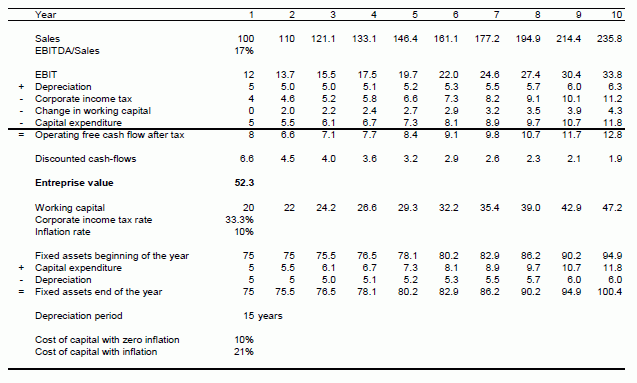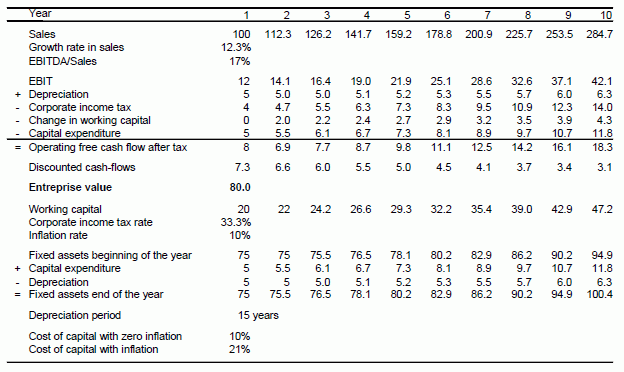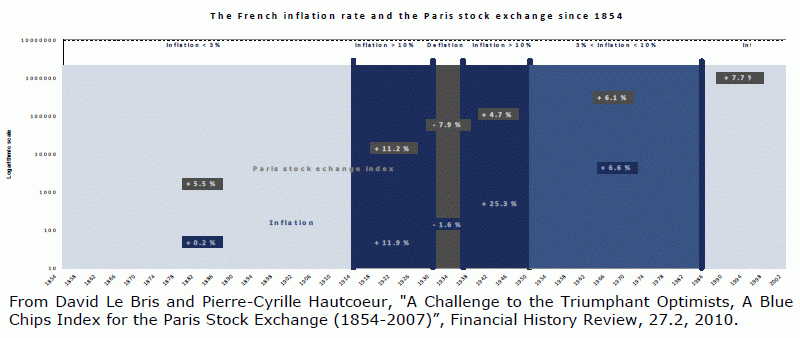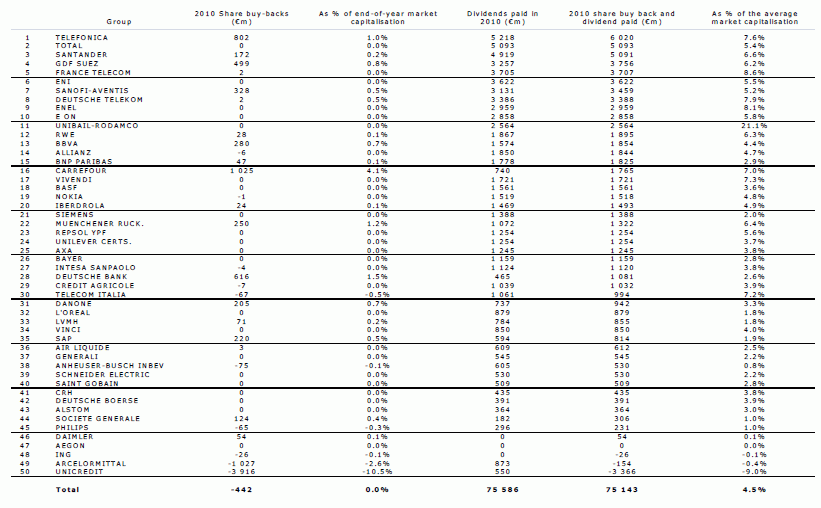Letter number 57 of April 2011
ALL ARTICLES
- TOPIC
- STATISTICS
- RESEARCH
- QUESTIONS & COMMENTS
News : What if inflation is up again?
We don’t believe that there will be a return to inflation in the euro zone any time soon.
It is true that a lot of cash has been – and continues to be – injected into the financial system in order to avoid a collapse. But simultaneously, the deleveraging of households, companies, banks and investment funds seems to us to be intuitively likely to set off these cash injections, the initial reason for which was to counter the effects of this massive deleveraging.
There are some who argue that inflation would enable certain governments to pay off their debts (in funny money) which are becoming increasingly onerous, and that this alternative is preferable to war (well they’re certainly right about that). Let’s think about it for a moment. What would the impact of a return to inflation be on firms and their shareholders?
The same people say that a firm will only have to pass on any increase in its cost prices in order to protect itself from inflation. Big mistake! They couldn’t be more wrong!
As any reader of the Vernimmen will know, the value of a firm and of its shares is more a function of its free cash flows than of its results (1).
A firm whose earnings are regularly absorbed by the change in its working capital and its capital expenditures will not be worth much. This is where the difference lies between say Danone, and a number of farming co-operatives which, from a financial point of view, are not worth very much.
Inflation will lead to an increase in working capital which, in most cases, will be higher than the increase in EBITDA or in EBIT that it results in.
Let's take a company with sales of 100, EBITDA of 17, depreciation and amortisation of 5, working capital of 20 stable excluding inflation and corporation tax of 33%. To simplify matters, let’s say that it is neither carrying debt nor growing. In a context of low inflation, its operating cash flow is:
Now, let's say that inflation suddenly rises to 10% and that our company is able to pass it on to its customers. In this case, we have:
Which leads to a flow of less 0.9, which can't not have any consequences on the value of the firm.
Secondly, inflation is going to create a distortion between depreciation calculated on historical values (5) and the capital expenditures necessary for maintaining the industrial facilities in their existing condition 5 x 1.1 = 5.5, and we are not talking about increasing production capacity. The firm is only able to deduct one expense (depreciation) of 5, while maintaining its production facilities costs it, with the help of inflation, 5.5.
If the depreciation period for depreciable fixed assets is 15 years, depreciation will only be gradually revalued, at a rate of one-fifteenth per year. They will, however, always be behind inflation, penalising the firm's cash flow through tax. Without inflation, free cash flows are:
And now with inflation:
which is a 18% drop, although the firm is perfectly capable of passing on the inflation of its costs in its retail prices. What would happen if it couldn’t!
In the absence of inflation, we can estimate the value of this firm at 80, knowing that we used a cost of capital of 10% and a growth rate of zero.
With inflation at 10%, the cost of capital rises to (1 + 10%) x (1 + 10%) – 1 = 21% and the value of our firm falls to 52.3, which is 35% less than previously under the dual effect of lower real flows and the increase in the cost of capital.
In order to get back to the initial value of 80, at a constant EBITDA margin, sales would have to grow by 12.3%, ie, at 2.3% more than inflation.
A real fairy story! And it is not the profits of inflation (mainly the adjustment of the value of inventories as a result of the passage of time (1)) alone that will make up extra margin needed, especially at a time when logistics practices are a far cry from what they were in the 1960s and 1970s.
Which should be enough to dissuade you from wishing for a return to inflation! And we haven't even finished yet!
Along with these quantitative aspects, there are also aspects which are more qualitative, but no less real.
Inflation, and more specifically, its annual variations that are not always well predicted, creates uncertainties which makes forecasting more difficult and thus impacts negatively on the firm’s ability to invest over the long term.
Additionally, there is usually a gap between the time the company has to bear an increase in the cost of its production expenses and the time when it is able to pass this increase on to its customers, which is another source for the destruction of value.
The only gain that the firm can make is on its debt, providing that this debt is at a fixed rate and that the fixed-rate lenders allow themselves to be “fleeced” and that they don’t insist on a specific inflation risk premium to make up for the new risk that they are running.
It’s been 25 years now that Europe has enjoyed a low rate of inflation (2 to 3%) after 25 years of rising inflation which culminated, in France for example, in 1981 at 13.6%. As the graph below shows, the behaviour of the stock markets has something in common with the rate of inflation:
Finally, this should dispel the widespread idea that shares offer good protection against inflation. This graph shows that the purchasing power of the shareholder was only preserved when average inflation was below 3%: from 1854 to 1914, and since 1986.
Let’s hope that for investors, the next 25 years will also see a low rate of inflation. Having said that, investors aren’t the only members of society!
(1) For more information, see chapter 32 of the Vernimmen
(2) For more information, see chapter 36 of the Vernimmen
Statistics : Dividends and share buy-backs in Europe
With negative share buy-backs of €442m in 2010 for the top 50 listed groups in the euro-zone, one could believe that companies have yet to re start buying back their shares. The reality is a bit more complex as illustrated in the following table as 2 groups (Arcelor Mittal and Unicredit) have placed treasury shares in the market to raise close to €5bn of new equity. Without them, share buy-backs in 2010 from the top 50 euro-zone groups would have been €4,5bn. It is still a far cry from the figures for 2007 (€47bn) and 2008 (€41bn).
Dividends paid (€75bn) are up 5% compared to 2009, but have still a long way to go to equal those paid in 2008: €99bn. 3 groups have not paid a dividend due to liquidity concerns or the need to prop up their balance sheet: Daimler, AEGON and ING.
All in all cash returned by the top 50 euro zone groups were €75.1bn in 2010 versus €139.5bn in 2008.
For more on dividends and share buy-backs, see chapter 38 of the Vernimmen.
Research : Why don’t US issuers demand European fees for their IPOs?
Around 10 years ago, an article published in the Journal of Finance showed that the fees charged by US banks on IPOs were practically always 7% (1), suggesting a market that was not very competitive. This month we discuss an article (2) which shows that over the 1998-2007 period, 7% was still the standard rate in the USA, while the average rate for European IPOs is 4%. According to Abrahamson et al, nothing other than a lack of competition would justify such a difference.
The interesting point raised by the article is illustrated in the comparison it makes between US and European IPOs. Ten years ago, such a comparison would have had little meaning as the procedures used for IPOs were not the same and the markets were not as integrated as they are today. Over the period in question (1998-2007), the bookbuilding procedure (3) took hold on both sides of the Atlantic, and the banks that steer the procedure (bookrunners) are often the same (Goldman Sachs, Morgan Stanley and Merrill Lynch are the leaders in both the USA and in Europe). However, the market is more concentrated in the USA, with the three leaders totalling close to half of all IPOs, compared with 30% in Europe.
Firstly, Abrahamson et al show that the difference of three percentage points between US and European IPO fees remains when we compare equivalent operations (size, sector, composition of banking syndicate, year). In particular, the same banks charge higher fees in the USA than they do in Europe so this difference can’t be attributed to the differences between banks.
The difference is the most noticeable for “small” IPOs ($25 to 100m). A fee of exactly 7% is charged for over 95% of IPOs of this size in the USA.
In Europe, only 1% of IPOs reach 7% and the average is 4%. Economies of scale are made on larger IPOs, but the difference between the USA and Europe persists.
The article then sets out a list of possible reasons for the difference, and rejects them one after the other:
• Indirect costs could be higher in Europe, which would make the total cost equivalent. The main indirect cost during an IPO is the undervaluation of the share listed. Abrahamson et al show that undervaluation (4) is certainly not more frequent in Europe (the difference, which is statistically insignificant, is favourable to Europe).
• Legal costs are deducted from the fee in the USA, while they are paid separately in Europe. They should thus be deducted in the USA in order to make a fair comparison. This adjustment only reduces the difference minimally (less than half a percentage point).
• US retail banks have higher fixed costs, which increases the distribution cost of IPOs. If this explanation were to hold true, the difference would disappear for the biggest IPOs, which is not the case. The same argument is used to reject the assumption of higher analyst coverage costs.
• The legal risk is higher in the USA, which would justify a higher fee. The cost of the legal risk should, in fact, be included in the undervaluation. In the USA, subscribers to an IPO who launch legal proceedings, do so on the basis of the difference between the price paid and the price at which they sold the share on. So undervaluation not only helps to reduce the risk of legal proceedings by also the amount of the damages claimed. Additionally, Abrahamson et al show that a legal risk premium included in the fee should not exceed 0.58%.
The results of this article provide excellent arguments to US issuers who are likely to be keen to negotiate fees that are comparable to those charged in Europe.
(1) H.C. Chen and J.R. Ritter (2000), The seven percent solution, Journal of Finance, vol.55, pages 1105-1131.
(2) M. Abrahamson, T. Jenkinson and H. Jones (2009), Why don’t U.S. issuers demand European fees for IPOs?, Saïd Business School, University of Oxford.
(3) For more information, see chapter 30 of the Vernimmen.
(4) The authors measure under-performance by the over-performance of the share on the day of the IPO and on the fifth day of listing.
Q&A : The Alcon-Novartis takeover bid, or happy end to “The Good, the Bad and the Ugly”
Just before Christmas, a stock market battle in the USA ended just like in a good Western. Those who had equity (instead of the law) on their side won, and those who had sought to abuse their position of strength were forced to see reason, even though in the land of the Far West, strength is not always synonymous with certain victory.
It all started in April 2008, when Novartis reached an agreement with Nestlé, to buy, in several stages, its 77% stake in Alcon, Nestlé’s Swiss registered, US listed subsidiary. The first 25% was acquired at $143 per share. The balance was acquired at 180% per share, which works out at an average price of $168.
Then, since Swiss takeover law did not apply, and taking advantage of the fact that in the USA, unlike in Europe, it is possible to take control of a company without making an offer to the minority shareholders or by making a lower offer, Novartis blithely offered the Alcon minority shareholders the opportunity to give up their shares for $153, paid in Novartis shares, through a merger that it was able to force through, as it held the required majority of two-thirds.
Alcon's independent directors then did what they had to do. They declined to recommend the offer to the minority shareholders and they launched a campaign of resistance!
It lasted a year.
Finally, with a bit of help from the good performance of the stock market, Novartis resigned itself to adding a cash component to its initial offer, which gave the Alcon minority shareholders the same price as that received by the majority shareholder, i.e., $168.
So, as is often the case, our American friends are capable of the Good - standing up for healthy principles, as well as of the Bad - continuing to apply takeover rules which are the opposite extreme of the good governance they are constantly touting.
Nevertheless, all’s well that ends well, since the day on which Novartis announced that it was going to treat the minority shareholders in the same way as the majority shareholder, its share price rose by 5%. Which should be enough to discourage the Ugly, who may have been tempted to follow the bad example initially set by Novartis!








